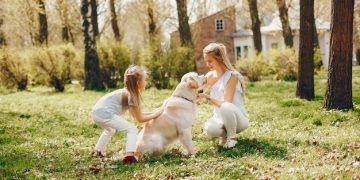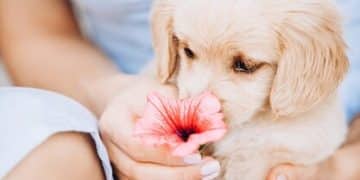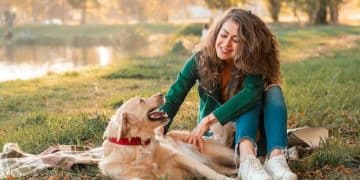New Puppy 101: Essential Training for the First 3 Months
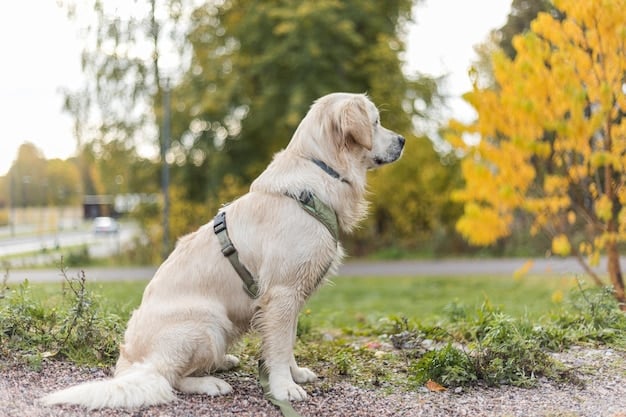
Anúncios
New Puppy 101: The First 3 Months – Essential Training for a Well-Adjusted Dog focuses on guiding new puppy owners through the crucial initial stages of puppyhood, covering vital topics such as socialization, basic command training, housebreaking, and preventing behavioral issues for a happy and well-behaved companion.
Bringing a new puppy home is an exciting time, but it’s also a period that requires dedication and the right knowledge. New Puppy 101: The First 3 Months – Essential Training for a Well-Adjusted Dog is your comprehensive guide to navigating this formative stage, ensuring you and your furry friend get off to the best possible start.
Anúncios
Preparing Your Home for a New Puppy
Before your new puppy arrives, it’s crucial to prepare your home to ensure its safety and comfort. This involves creating a puppy-proof environment and gathering essential supplies.
Puppy-Proofing Your Home
Puppies are naturally curious and love to explore, often using their mouths. Remove any potential hazards like electrical cords, cleaning supplies, and small objects that could be ingested.
Anúncios
Essential Supplies for Your New Puppy
Having the right supplies on hand will make the transition smoother. This includes a comfortable crate, food and water bowls, puppy food, toys, a leash, and collar.
- Crate: A safe haven for your puppy and a useful tool for housebreaking.
- Food and Water Bowls: Choose durable, easy-to-clean bowls.
- Puppy Food: Select a high-quality puppy food recommended by your veterinarian.
- Toys: Offer a variety of toys to keep your puppy entertained and prevent destructive chewing.
Preparing your home and gathering essential supplies beforehand minimizes stress for both you and your new puppy, setting the stage for a positive start.
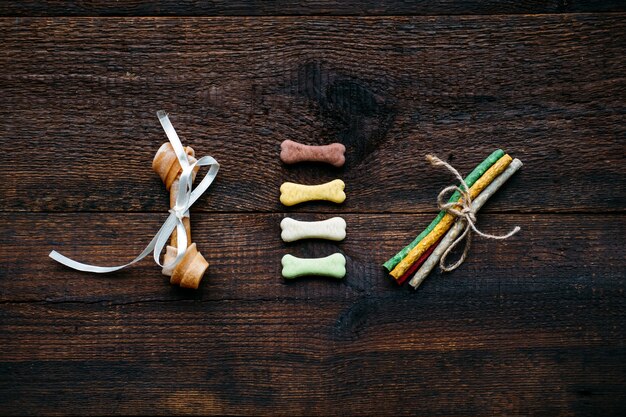
Socialization: Exposing Your Puppy to the World
Socialization during the first three months is critical for your puppy’s development. Exposing your puppy to various sights, sounds, people, and experiences helps them become well-adjusted and confident adults.
Importance of Early Socialization
Early socialization helps prevent fear and aggression later in life. Positive experiences during this period shape your puppy’s perception of the world.
Safe Socialization Practices
Ensure all socialization experiences are positive and controlled. Avoid overwhelming your puppy and always supervise interactions with other animals and people.
- Introduce different sounds: Expose your puppy to everyday noises like vacuum cleaners, doorbells, and traffic.
- Meet various people: Introduce your puppy to people of different ages, genders, and appearances.
- Explore new environments: Take your puppy to different locations like parks, beaches, and pet-friendly stores.
Proper socialization lays the foundation for a well-behaved and confident dog. Remember to always monitor your puppy’s comfort level and adjust accordingly.
Basic Command Training: Building a Foundation
Starting basic command training early helps establish clear communication and builds a strong bond between you and your puppy. Simple commands like “sit,” “stay,” and “come” are essential.
Teaching “Sit”
Hold a treat in front of your puppy’s nose and slowly move it upwards and backwards. As your puppy follows the treat, their rear will naturally lower into a sit. Say “sit” as they perform the action and reward them with the treat.
Teaching “Stay”
Have your puppy sit and say “stay” in a firm voice. Initially, keep the “stay” short, gradually increasing the duration as your puppy becomes more reliable. Reward them for staying in place.
Teaching “Come”
Use a cheerful tone and say “come,” while gently pulling your puppy towards you with the leash. When they reach you, praise them enthusiastically and give them a treat.
Consistent and positive reinforcement is key to successful basic command training. Keep training sessions short and fun, and always end on a positive note.
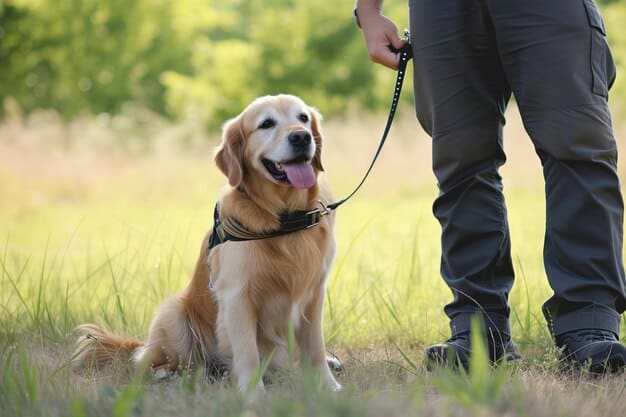
Housebreaking: Establishing a Potty Routine
Housebreaking is a crucial part of puppy training. Establishing a consistent potty routine and using positive reinforcement can make the process smoother and less stressful.
Creating a Potty Schedule
Take your puppy outside frequently, especially after waking up, eating, and playing. Consistency is key to establishing a reliable potty routine.
Positive Reinforcement for Potty Training
When your puppy eliminates outside, praise them enthusiastically and offer a treat. This reinforces the desired behavior and encourages them to repeat it.
Dealing with Accidents
Accidents are inevitable during housebreaking. Clean them up immediately with an enzymatic cleaner to eliminate odors and prevent repeat offenses.
- Watch for signs: Learn to recognize your puppy’s signals that they need to go outside, such as circling, sniffing, or squatting.
- Use a designated potty spot: Always take your puppy to the same area outside to eliminate, so they associate it with going potty.
- Be patient: Housebreaking takes time and consistency. Don’t get discouraged by accidents; stay positive and persistent.
Housebreaking requires patience and consistency. By establishing a routine and using positive reinforcement, you can successfully train your puppy to eliminate outside.
Nipping and Biting: Managing Puppy Behavior
Puppy nipping and biting are common behaviors, but it’s important to address them early on. Teaching your puppy appropriate bite inhibition is crucial for their development.
Understanding Puppy Nipping
Puppies explore the world with their mouths, and nipping is often a way for them to play and interact. However, it’s important to teach them that nipping humans is not acceptable.
Teaching Bite Inhibition
When your puppy nips you, say “ouch” in a loud, clear voice and immediately stop playing. This teaches them that their biting causes the play to end.
Redirecting Nipping Behavior
Offer your puppy appropriate chew toys when they start nipping. This redirects their biting energy to a more acceptable outlet.
- Provide plenty of chew toys: Keep a variety of chew toys on hand to satisfy your puppy’s natural urge to chew.
- Avoid rough play: Refrain from engaging in rough play that encourages biting and nipping.
- Be consistent: Everyone in the household should use the same techniques to address nipping behavior.
Consistently addressing nipping and biting from the start can help your puppy learn appropriate behavior and prevent future issues.
Preventing Separation Anxiety
Separation anxiety can be a significant issue for some puppies. Teaching your puppy to be comfortable alone from an early age can help prevent this condition.
Gradual Exposure to Alone Time
Start by leaving your puppy alone for short periods, gradually increasing the duration as they become more comfortable. This helps them learn that being alone is not scary.
Creating a Safe Space
Ensure your puppy has a comfortable and safe space to retreat to when you’re not around, such as a crate or bed. This provides them with a sense of security.
Avoid Making a Fuss
When leaving and returning home, avoid making a big fuss. This helps your puppy stay calm and prevents them from associating your departures with anxiety.
- Provide distractions: Leave your puppy with a puzzle toy or chew toy to keep them entertained while you’re gone.
- Practice short departures: Leave the house for short periods, such as a few minutes, and gradually increase the duration.
- Stay calm and confident: Your puppy can sense your emotions, so it’s important to remain calm and confident when leaving them alone.
Taking proactive steps to prevent separation anxiety can make a big difference in your puppy’s overall well-being and happiness.
| Key Point | Brief Description |
|---|---|
| 🏠 Home Prep | Puppy-proof your home and gather essential supplies before arrival. |
| 🐾 Socialization | Expose your puppy to various sights, sounds, and people safely. |
| 🦮 Basic Training | Start teaching simple commands like “sit,” “stay,” and “come” early. |
| 🚽 Housebreaking | Establish a consistent potty routine with positive reinforcement. |
Frequently Asked Questions
▼
New puppies typically need to be fed three to four times a day. Follow your vet’s recommendations based on your puppy’s age, breed, and specific dietary needs.
▼
After your puppy has received its first round of vaccinations, it’s safe to start taking them for short walks in low-traffic areas. Consult your veterinarian for guidance.
▼
When your puppy bites, say “ouch” loudly to indicate it hurts, then stop playing. Redirect their biting behavior to a chew toy instead.
▼
A healthy puppy should be energetic, have a good appetite, and have a shiny coat. Their eyes should be clear, and their stools should be firm.
▼
House training can vary from puppy to puppy, but generally, it can take anywhere from four to six months with consistency and positive reinforcement techniques.
Conclusion
The first three months with your new puppy are a critical period for training and socialization. By following these essential tips, you can lay a solid foundation for a happy, well-adjusted dog and a long, fulfilling relationship together.

